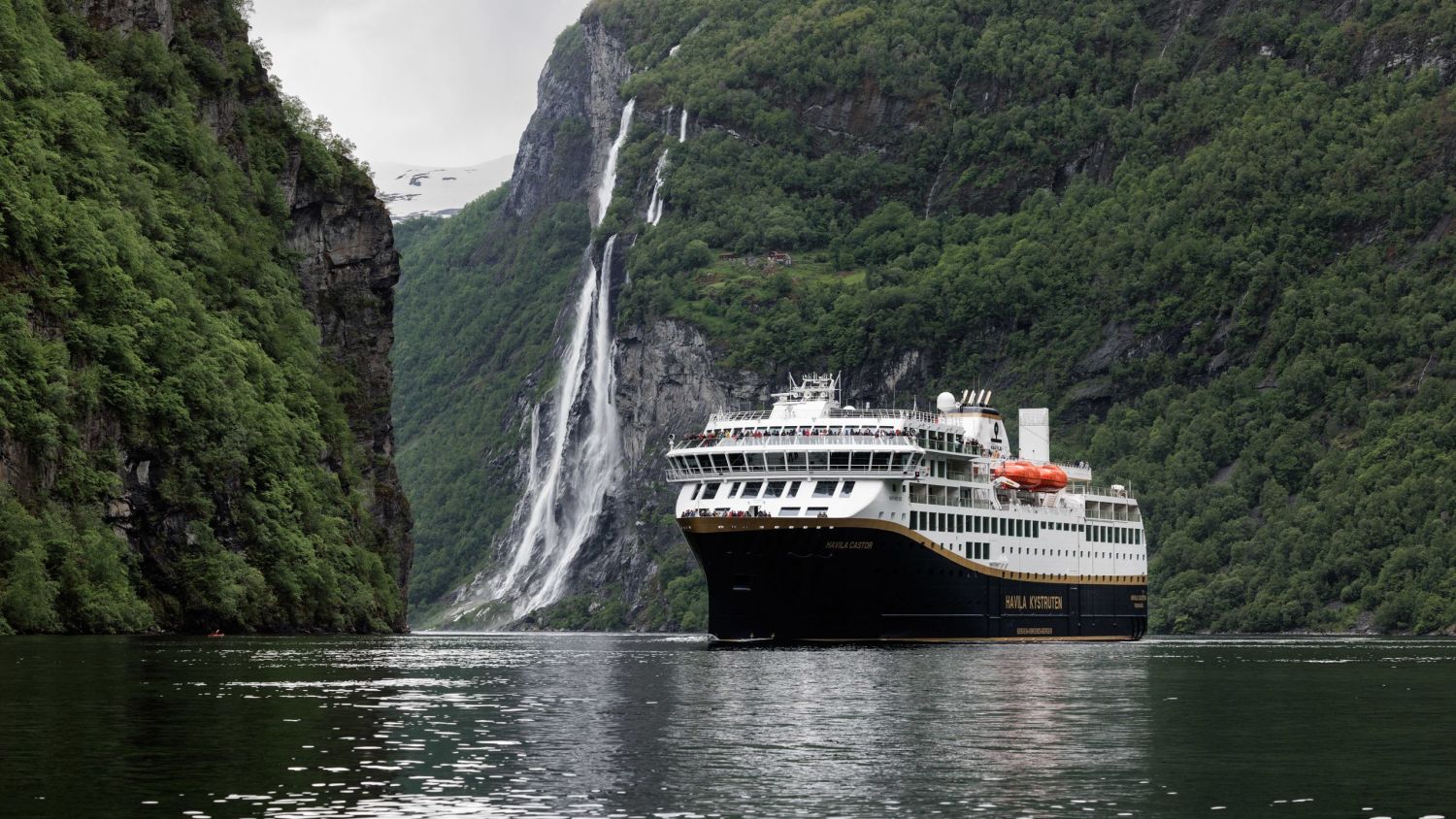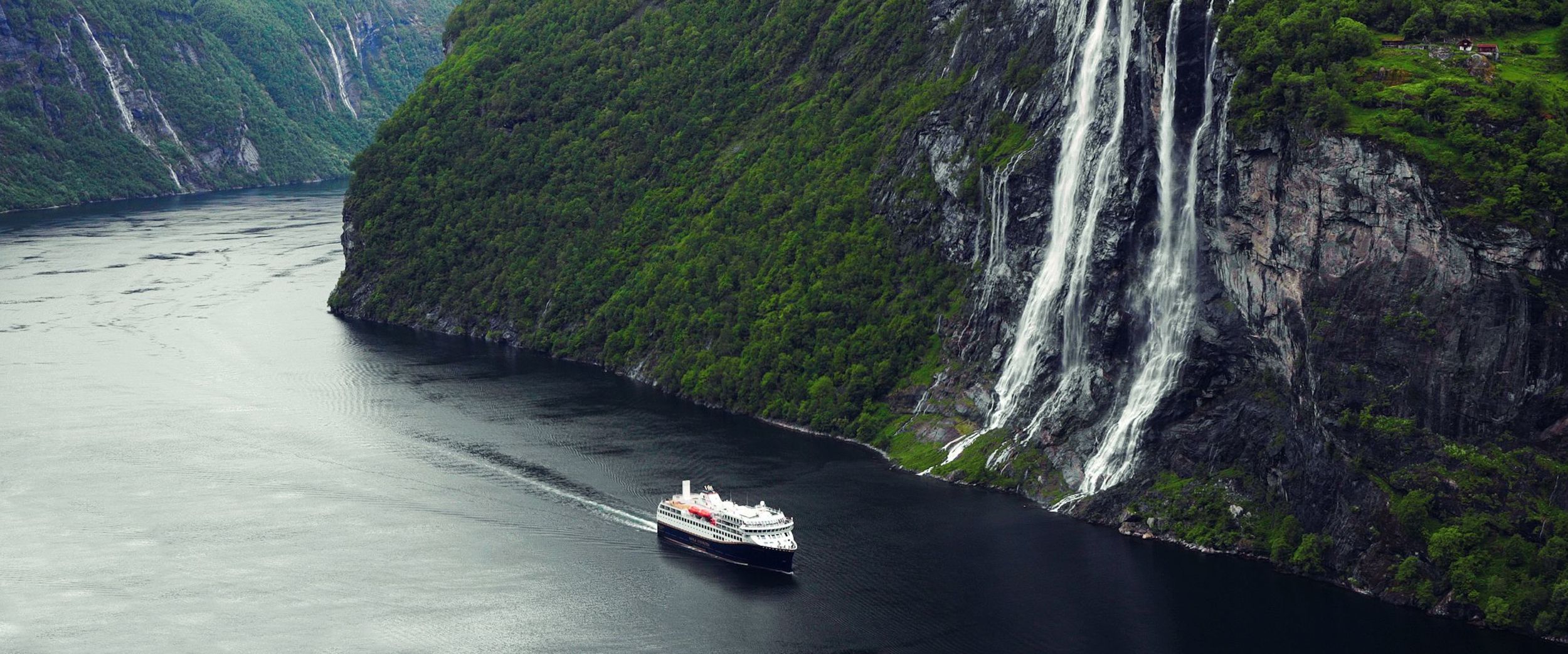Havila Kystruten makes history in the Geirangerfjord

Havila Kystruten's newest ship, Havila Castor, made history in the Geirangerfjord Thursday 2 June 2022 – operating the first zero emission cruise through the world heritage fjord.
Havila Kystruten's ships are built for the future and are the most environmentally friendly ships along the Norwegian coast. With a battery pack of 6.1 Megawatt hours (MWh), the world's largest battery pack on a passenger ship, the ships can sail up to 4 hours on pure battery power. In combination with liquefied natural gas (LNG), CO2 emissions are reduced by 30 % and NOX emissions by 90 % compared to similar vessels that use fossil fuel.
The summer season is underway, and thus the Geirangerfjord is open for cruise and ferry traffic. In 2018, the Norwegian Parliament decided that cruise ships and ferries must sail emission-free in Norwegian World Heritage fjords as soon as technically possible, and no later than 2026. On Thursday, Havila Castor carried out the first voyage in the Geirangerfjord emission-free and silently.
“Even the weather was on our side yesterday and turned out to be much better than expected. This was a milestone for us. We proved that we can deliver on the future requirements from the authorities”, says Bent Martini, CEO of Havila Kystruten.
Havila Castor used battery-powered propulsion only, for three hours this Thursday.
“We spent just over 60 % of the battery's capacity on this voyage and that demonstrates to us that the goal of four hours on battery clearly is achievable. With even more testing and adaptation of all energy use on board, we will eventually be able to sail the entire world heritage emission-free without major challenges”, says Martini.
In order to have the opportunity to use the batteries on board to a greater extent than now, Martini is calling for access to shore power along the coast.“We want to utilize our battery power even further, but to do that we rely on having in place the infrastructure for shore power to charge the ship on clean hydropower. We hope this will be operational in selected ports of call soon. In addition, we plan for a gradual blending of liquefied biogas to replace the natural gas over time. This requires biogas to made available to a large enough extent to meet our needs”, says Martini.

A milestone
The environmental foundation ZERO was also on board the ship during the historic voyage.
“This voyage is a milestone, the culmination of many years of work. Havila Kystruten has shown that it is entirely possible to sail emission-free in the World Heritage fjords now, four years before the requirements set by the Parliament. This should motivate other players to follow suit”, says Harald Maaland, transport consultant at ZERO.
“Now we must ensure further progress: The Parliament`s decision from 2018 must be regulated as soon as possible, and the requirement for zero emissions must be extended to apply to all fjords. Charging infrastructure in the ports must also be in place”.
Havila Castor in the Geirangerfjord powered by battery.
With steady hand
Truls Bruland was standing on the bridge when Havila Castor sailed into Geiranger for the first time, and as captain of the ship he was clearly proud.
“We have a fantastic ship that behaves like a dream at sea. This is a state-of-the-art ship that is easy to manouevre”, says Bruland.
“And it is of course also great that we can help take care of the areas we sail in, by contributing to reduced emissions”.
For a ship like Havila Castor to function as well as possible, Bruland and his crew on the bridge depend on a good collaboration with the engine room, where chief engineer Allan William Johansen is responsible.
“This has been a fun, but hectic and special day for us. When we test the ship as today, there is a lot that needs to be done, and not least it is important that the entire ship optimizes its power consumption, for us to use as much energy as possible on propulsion”, says Johansen.
“I feel we succeeded today, and that we gained good experiences today, ensuring we can sail even further emission-free next time”.
A shared responsibility
Prior to the change to battery operation, the passengers on board were encouraged to be aware of the use of electricity for mobile charging, light and heating in the cabin, in addition to the ship's hotel operation reducing its consumption.
“It requires some resources to cook for over 300 passengers, as well for lighting on board and to heat the ship. When we sail emission-free, we do everything we can to reduce the consumption of electricity, and sailing like this becomes a shared responsibility, says Sandra Ness, head of climate & environment in Havila Kystruten.
Starting on this voyage, Havila Kystruten launched its new Eco-Voyager Program for guests on board.
“If we are to succeed in climate, environment and sustainability, it is important that we also involve our guests on board”, says Ness.
“The program aims to give our guests the opportunity to get involved and make conscious choices on board, and thereby contribute to a more sustainable use of human and material resources. We want to inspire and encourage our guests to take small steps that affect everyday life on board positively in terms of energy, water, garbage, cleaning, and thus also crew, during the voyage around the coast”, she concludes.
The Eco-Voyager Program has been launched on havilavoyages.com, where guests can read more about the project, and see the checklist for what measures they can contribute to on their voyage.
